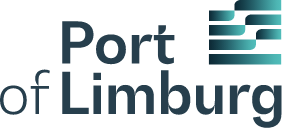
Genk – Tom Vandeput, Deputy for Economy and Chairman of POM Limburg, Benjamin Hermans, CEO of Port of Limburg, Pascal Vranken, CCO of H.Essers, and Wesley Mazzei, General Manager Industrial Real Estate at Group Machiels, today provided an update on the construction of the new inland shipping terminal in Genk.
The terminal is designed for the transfer of containers between trucks and inland vessels and vice versa. This connects the 430-meter quay along the Albert Canal, constructed by the Flemish Waterway, to the road network. “The container terminal is being developed with the support of 1.5 million euros in ERDF funds. From the very start of our economic future strategy, SALKturbo, we identified this project as a key leverage project. This investment offers new sustainable growth opportunities for the Limburg logistics sector,” said Tom Vandeput.
The Logistic Gateway of Limburg
The Ford factory was once the flagship of the Limburg economy. Barely 10 years after the announcement of its closure, the site has been transformed into a logistics hotspot, Logistics Valley Flanders. Tom Vandeput, Deputy for Economy and Chairman of POM Limburg, stated: “The rapid conversion of the site is an example for the rest of Flanders. The swift remediation and redevelopment of the industrial land was initiated as a SALK action in 2014. This action can be completed by 2024 thanks to the good cooperation between Flanders, the city of Genk, the Flemish Waterway, and POM Limburg. It is particularly the willingness to invest by major Limburg logistics players such as Port of Limburg, H.Essers, and Genk Green Logistics that has transformed the site into the logistics gateway of Limburg.”
Wesley Mazzei, General Manager Industrial Real Estate at Group Machiels:
“The development of Port of Limburg (POL) along the Albert Canal is a crucial step in strengthening the transport infrastructure in Limburg and the wider Euregion. Thanks to its strategic location near the German border and multimodal access via highways, rail, and waterways, POL provides a solution to increasing congestion issues and serves as an essential logistics hub connecting the seaports of Antwerp and Rotterdam with the hinterland. In this way, Port of Limburg contributes to reducing traffic pressure and emissions, in line with the region’s sustainability ambitions. The terminal will not only operate efficiently but also serve as a sustainable example, incorporating advanced technologies and a focus on green energy. This strengthens both the future-proofing of the transport sector in Limburg and the province’s position as a logistics hotspot in the Euregion.”
Albert Canal
Due to the lack of sufficient infrastructure for loading and unloading inland vessels, the Albert Canal is currently underutilized. Benjamin Hermans, CEO of Port of Limburg: “With the raising of the bridges and widening of the Albert Canal, the canal is now more accessible to larger cargo ships with greater transport capacity, making it a more sustainable and cost-effective alternative to truck transport. With the 1.5 million euros in ERDF funds, we can develop a high-performance terminal area of 120,000 m². A large automated gate will be constructed where incoming trucks can check in at unmanned kiosks, ensuring a smooth flow of trucks across the site. This will minimize truck waiting times. Additionally, there will be significant investments in state-of-the-art cranes and innovative security technologies. Port of Limburg is investing approximately 40 million euros on its own.”
All the puzzle pieces now fit together. Deputy for Economy Tom Vandeput: “This investment was the missing link between the quay and the public road and is essential to making Port of Limburg a multimodal hub. The investment contributes to the sustainability of freight transport and the logistics sector in Limburg. The goal is to remove 240,000 trucks from the road. This equates to 28.8 million driven kilometers, half of which are in Limburg.”
Pascal Vranken, CCO of H.Essers: “Trucks will still be used to transport goods to the nearby rail terminal for further transport to destinations such as Germany, Austria, and Switzerland, as well as for last-mile transport within the service area of the Port of Limburg terminal. This investment further strengthens Limburg’s international position as a logistics region.”
Logistics, an Economic Flagship
The logistics sector (transport and storage) comprises 750 companies and contributes 1.6 billion euros in gross added value. The sector accounts for more than 18,000 direct jobs and 1,100 self-employed workers. Deputy for Economy Tom Vandeput: “With these figures, the sector is very important for the Limburg economy. With the Logistics Campus in Zone A of the former Ford site, we are strengthening the sector in terms of innovation and sustainability. An iconic gateway building will offer space for various functions such as administrative services, training facilities, flexible spaces, and more. It will form the true finishing touch of the Ford site reconversion.”


